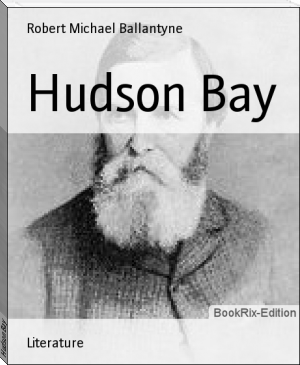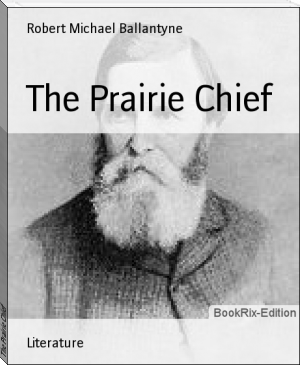Hudson Bay by Robert Michael Ballantyne (ebook reader library TXT) 📖

- Author: Robert Michael Ballantyne
Book online «Hudson Bay by Robert Michael Ballantyne (ebook reader library TXT) 📖». Author Robert Michael Ballantyne
The summer dress of the Indian is almost entirely provided for him by the Hudson Bay Company. It consists chiefly of a blue or grey cloth, or else a blanket capote reaching below the knee, made much too loose for the figure, and strapped round the waist with a scarlet or crimson worsted belt. A very coarse blue striped cotton shirt is all the underclothing they wear, holding trousers to be quite superfluous; in lieu of which they make leggins of various kinds of cloth, which reach from a few inches above the knee down to the ankle. These leggins are sometimes very tastefully decorated with bead-work, particularly those of the women, and are provided with flaps or wings on either side.
The costume, however, is slightly varied in winter. The blanket or cloth capote is then laid aside for one of smoked red-deer skin, which has very much the appearance of chamois leather. This is lined with flannel, or some other thick, warm substance, and edged with fur (more for ornament, however, than warmth) of different kinds. Fingerless mittens, with a place for the thumb, are also adopted; and shoes or moccasins of the same soft material. The moccasins are very beautiful, fitting the feet as tightly as a glove, and are tastefully ornamented with dyed porcupine quills and silk thread of various colours, at which work the women are particularly _au fait_. As the leather of the moccasin is very thin [see note 1], blanket and flannel socks are worn underneath--one, two, or even four pairs, according to the degree of cold; and in proportion as these socks are increased in number, the moccasin, of course, loses its elegant appearance.
The Indian women are not so good-looking as the men. They have an awkward, slouching gait, and a downcast look--arising, probably, from the rude treatment they experience from their husbands; for the North American Indians, like all other savages, make complete drudges of their women, obliging them to do all the laborious and dirty work, while they reserve the pleasures of the chase for themselves. Their features are sometimes good; but I never saw a really pretty woman among the Crees. Their colour, as well as that of the men, is a dingy brown, which, together with their extreme filthiness, renders them anything but attractive. They are, however, quiet, sweet-tempered, and inoffensive creatures, destitute as well of artificial manners as of _stays_. Their dress is a gown, made without sleeves, and very scanty in the skirt, of coarse blue or green cloth; it reaches down to a little under the knee, below which their limbs are cased in leggins beautifully ornamented. Their whole costume, however, like that of the men, is almost always hid from sight by a thick blanket, without which the Indian seldom ventures abroad. The women usually make the top of the blanket answer the purpose of a head-dress; but when they wish to appear very much to advantage, they put on a cap. It is a square piece of blue cloth, profusely decorated with different-coloured beads, and merely sewed up at the top. They wear their hair in long straggling locks, which have not the slightest tendency to curl, and occasionally in queues or pigtails behind; but in this respect, as in every other, they are very careless of their personal appearance.
These primitive children of the forest live in tents of deerskin or bark; and sometimes, where skins are scarce, of branches of trees. They are conically shaped, and are constructed thus:--The Indian with his family (probably two wives and three or four children) arrives in his bark canoe at a pretty level spot, sheltered from the north wind, and conveniently situated on the banks of a small stream, where the fish are plentiful, and pine branches (or brush), for the floor of the tent, abundant. Here he runs his canoe ashore, and carries his goods and chattels up the bank. His first business is to cut a number of long poles, and tie three of them at the top, spreading them out in the form of a tripod. He then piles all the other poles round these, at half a foot distance from each other, and thus encloses a circle of between fifteen and twenty feet in diameter. Over the poles (if he is a good hunter, and has plenty of deer-skins) he spreads the skin tent, leaving an opening at the top for the egress of the smoke. If the tent be a birch-bark one, he has it in separate rolls, which are spread over the poles till the whole is covered. A small opening is left facing the river or lake, which serves for a doorway; and this is covered with an old blanket, a piece of deer-skin, or, in some instances, by bison-skin or buffalo robe. The floor is covered with a layer of small pine branches, which serve for carpet and mattress; and in the centre is placed the wood fire, which, when blazing brightly, gives a warmth and comfort to the slight habitation that could scarcely be believed. Here the Indian spends a few days or weeks, according to the amount of game in the vicinity, and then removes to some other place, carrying with him the covering of the tent, but leaving the poles standing, as they would be cumbrous to carry in his small canoe, and thousands may be had at every place where he may wish to land.
The Indian canoe is an exceedingly light and graceful little craft, and well adapted for travelling in through a wild country, where the rivers are obstructed by long rapids, waterfalls, and shallows. It is so light that one man can easily carry it on his shoulders over the land, when a waterfall obstructs his progress; and as it only sinks about four or six inches in the water, few places are too shallow to float it. The birch bark of which it is made is about a quarter of an inch thick; and the inside is lined with extremely thin flakes of wood, over which a number of light timbers are driven, to give strength and tightness to the machine. In this frail bark, which measures from twelve, fifteen, thirty, to forty feet long, and from two to four feet broad in the middle, a whole Indian family of eight or ten souls will travel hundreds of miles, over rivers and lakes innumerable; now floating swiftly down a foaming rapid, and anon gliding over the surface of a quiet lake, or _making a portage_ overland when a rapid is too dangerous to descend; and, while the elders of the family assist in carrying the canoe, the youngsters run about plucking berries, and the shaggy little curs (one or two of which are possessed by every Indian family) search for food, or bask in the sun at the foot of the baby's cradle, which stands bolt upright against a tree, while the child gazes upon all these operations with serene indifference.
Not less elegant and useful than the canoe is the snowshoe, without which the Indian would be badly off indeed. It is not, as many suppose, used as a kind of _skate_, with which to _slide_ over the snow, but as a machine to prevent, by its size and breadth, the wearer from sinking into the snow; which is so deep that, without the assistance of the snowshoe, no one could walk a quarter of a mile through the woods in winter without being utterly exhausted.
It is formed of two thin pieces of light wood, tied at both ends, and spread out near the middle, thus making a kind of long oval, the interior of which is filled up with network of deer-skin threads. Strength is given to the frame by placing wooden bars across; and it is fastened _loosely_ to the foot by a slight line going over the toe. In case, however, it may be supposed that by a shoe I mean an article something the size of a man's foot, it may be as well to state that snow-shoes measure from _four_ to _six feet_ long, and from thirteen to twenty inches wide. Notwithstanding their great size, the extreme lightness of their materials prevents them being cumbrous; and, after a little practice, a traveller forgets that he has them on, if the weather be good for such walking. Frosty weather is the best for snow-shoe travelling, as the snow is fine and dust-like, and falls through the net-work. If the weather be warm, the wet snow renders the shoe heavy, and the lines soon begin to gall the feet. On these shoes an Indian will travel between twenty and thirty miles a day; and they often accomplish from thirty to forty when hard pressed.
The food of the Indian varies according to circumstances. Sometimes he luxuriates on deer, partridges, and fat beaver; whilst at others he is obliged to live almost entirely on fish, and not unfrequently on _tripe-de-roche_. This substance, however, does no more than retard his ultimate destruction by starvation; and unless he meets with something more nourishing, it cannot prevent it. When starving, the Indian will not hesitate to appease the cravings of hunger by resorting to cannibalism; and there were some old dames with whom I was myself acquainted, who had at different periods eaten several of their children. Indeed, some of them, it was said, had also eaten their husbands!
The following anecdote, related to me by my friend Carles, who spent many years of his life among the North American Indians, depicts one of the worst of these cases of cannibalism.
It was in the spring of 18 hundred and something that Mr Carles stood in the Indian Hall of one of the far-distant posts in Athabasca, conversing with a party of Chipewyan Indians, who had just arrived with furs from their winter hunting-grounds. The large fires of wood, sparkling and blazing cheerfully up the wide chimney, cast a bright light round the room, and shone upon the dusky countenances of the Chipewyans, as they sat gravely on the floor, smoking their spwagans in silence. A dark shade lowered upon every face, as if thoughts of an unpleasant nature disturbed their minds; and so it was. A deed of the most revolting description had been perpetrated by an Indian of the Cree tribe, and they were about to relate the story to Mr Carles.
After a short silence, an old Indian removed his pipe, and, looking round upon the others, as if to ask their consent to his becoming spokesman, related the particulars of the story, the substance of which I now give.
Towards the middle of winter, Wisagun, a Cree Indian, removed his encampment to another part of the country, as game was scarce in the place where he had been residing. His family consisted of
 Have you ever thought about what fiction is? Probably, such a question may seem surprising: and so everything is clear. Every person throughout his life has to repeatedly create the works he needs for specific purposes - statements, autobiographies, dictations - using not gypsum or clay, not musical notes, not paints, but just a word. At the same time, almost every person will be very surprised if he is told that he thereby created a work of fiction, which is very different from visual art, music and sculpture making. However, everyone understands that a student's essay or dictation is fundamentally different from novels, short stories, news that are created by professional writers. In the works of professionals there is the most important difference - excogitation. But, oddly enough, in a school literature course, you don’t realize the full power of fiction. So using our website in your free time discover fiction for yourself.
Have you ever thought about what fiction is? Probably, such a question may seem surprising: and so everything is clear. Every person throughout his life has to repeatedly create the works he needs for specific purposes - statements, autobiographies, dictations - using not gypsum or clay, not musical notes, not paints, but just a word. At the same time, almost every person will be very surprised if he is told that he thereby created a work of fiction, which is very different from visual art, music and sculpture making. However, everyone understands that a student's essay or dictation is fundamentally different from novels, short stories, news that are created by professional writers. In the works of professionals there is the most important difference - excogitation. But, oddly enough, in a school literature course, you don’t realize the full power of fiction. So using our website in your free time discover fiction for yourself. 




Comments (0)